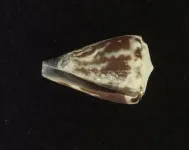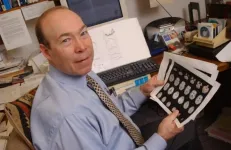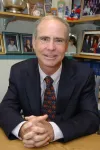Cone snail venom shows potential for treating severe malaria
Study finds anti-adhesion drugs may hold the key to treating malaria, COVID-19, aids and other emerging diseases
2021-02-18
(Press-News.org) Severe forms of malaria such as Plasmodium falciparum may be deadly even after treatment with current parasite-killing drugs. This is due to persistent cyto-adhesion of infected erythrocytes even though existing parasites within the red blood cells are dead. As vaccines for malaria have proved less than moderately effective, and to treat these severe cases of P. falciparum malaria, new avenues are urgently needed. Latest estimates indicate that more than 500 million cases of malaria and more than 400,000 deaths are reported worldwide each year. Anti-adhesion drugs may hold the key to significantly improving survival rates.
Using venom from the Conus nux, a species of sea snail, a first-of-its-kind study from Florida Atlantic University's Schmidt College of Medicine in collaboration with FAU's Charles E. Schmidt College of Science and the Chemical Sciences Division, National Institute of Standard and Technology, United States Department of Commerce, suggests that these conotoxins could potentially treat malaria. The study provides important leads toward the development of novel and cost-effective anti-adhesion or blockade-therapy pharmaceuticals aimed at counteracting the pathology of severe malaria.
Results, published in the Journal of Proteomics, expand the pharmacological reach of conotoxins/ conopeptides by revealing their ability to disrupt protein-protein and protein-polysaccharide interactions that directly contribute to the disease. Similarly, mitigation of emerging diseases like AIDS and COVID-19 also could benefit from conotoxins as potential inhibitors of protein-protein interactions as treatment. Venom peptides from cone snails has the potential to treat countless diseases using blockage therapies.
"Molecular stability, small size, solubility, intravenous delivery, and no immunogenic response make conotoxins excellent blockade-therapy candidates," said Andrew V. Oleinikov, Ph.D., corresponding author and a professor of biomedical science, FAU's Schmidt College of Medicine. "Conotoxins have been vigorously studied for decades as molecular probes and drug leads targeting the central nervous systems. They also should be explored for novel applications aimed to thwart amiss cellular responses or foil host parasite interactions through their binding with endogenous and exogenous proteins. Further investigation is likely to yield breakthroughs in fields continuously toiling for more efficient therapeutic approaches such as cancer, autoimmune diseases, novel emerging viral diseases as well as malaria where venom-based peptidic natural products can be put into practice."
The disruption of protein-protein interactions by conotoxins is an extension of their well known inhibitory action in many ion channels and receptors. Disabling prey by specifically modulating their central nervous system is a ruling principle in the mode of action of venoms.
"Among the more than 850 species of cone snails there are hundreds of thousands of diverse venom exopeptides that have been selected throughout several million years of evolution to capture their prey and deter predators," said Frank Marí, Ph.D., corresponding author and senior advisor for biochemical sciences at the National Institute of Standard Technology. "They do so by targeting several surface proteins present in target excitable cells. This immense biomolecular library of conopeptides can be explored for potential use as therapeutic leads against persistent and emerging diseases affecting non-excitable systems."
For the study, researchers used high-throughput assays to study Conus nux collected off the Pacific coast of Costa Rica. They revealed the in vitro capacity of cone snail venom to disrupt protein-protein and protein-polysaccharide interactions that directly contribute to pathology of P. falciparum malaria. They determined that six fractions from the venom inhibit the adhesion of recombinant P. falciparum erythrocyte membrane protein 1 (PfEMP-1) domains to their corresponding receptors, which express on the endothelial microvasculature and the placenta.
The results are noteworthy as each of these six venom fractions, which contain a mostly single or a very limited set of peptides, affected binding of domains with different receptor specificity to their corresponding receptors, which are proteins (CD36 and ICAM-1), and polysaccharide. This activity profile suggests that the peptides in these conotoxin fractions either bind to common structural elements in the different PfEMP1 domains, or that a few different peptides in the fraction may interact efficiently (concentration of each is lower proportionally to the complexity) with different domains.
INFORMATION:
Study co-authors are Alberto Padilla, Ph.D., first author and a former graduate student, FAU's Schmidt College of Medicine; Sanaz Dovell, Ph.D., a former student in FAU's Charles E. Schmidt College of Science; Olga Chesnokov, Ph.D., research associate, FAU's Schmidt College of Medicine; and Mickelene Hoggard, Ph.D., Chemical Sciences Division, National Institute of Standard and Technology.
This research is supported in part by the National Institute of Allergy and Infectious Diseases (grants R21A137721 and R01AI092120) awarded to Oleinikov.
About the Charles E. Schmidt College of Medicine:
FAU's Charles E. Schmidt College of Medicine is one of approximately 155 accredited medical schools in the U.S. The college was launched in 2010, when the Florida Board of Governors made a landmark decision authorizing FAU to award the M.D. degree. After receiving approval from the Florida legislature and the governor, it became the 134th allopathic medical school in North America. With more than 70 full and part-time faculty and more than 1,300 affiliate faculty, the college matriculates 64 medical students each year and has been nationally recognized for its innovative curriculum. To further FAU's commitment to increase much needed medical residency positions in Palm Beach County and to ensure that the region will continue to have an adequate and well-trained physician workforce, the FAU Charles E. Schmidt College of Medicine Consortium for Graduate Medical Education (GME) was formed in fall 2011 with five leading hospitals in Palm Beach County. The Consortium currently has five Accreditation Council for Graduate Medical Education (ACGME) accredited residencies including internal medicine, surgery, emergency medicine, psychiatry, and neurology.
About Florida Atlantic University:
Florida Atlantic University, established in 1961, officially opened its doors in 1964 as the fifth public university in Florida. Today, the University serves more than 30,000 undergraduate and graduate students across six campuses located along the southeast Florida coast. In recent years, the University has doubled its research expenditures and outpaced its peers in student achievement rates. Through the coexistence of access and excellence, FAU embodies an innovative model where traditional achievement gaps vanish. FAU is designated a Hispanic-serving institution, ranked as a top public university by U.S. News & World Report and a High Research Activity institution by the Carnegie Foundation for the Advancement of Teaching. For more information, visit http://www.fau.edu.
[Attachments] See images for this press release:

ELSE PRESS RELEASES FROM THIS DATE:
2021-02-18
Extending the symptoms that trigger a PCR test for COVID-19 could help detect around a third more cases of the disease.
New research led by researchers at King's College London and published in the Journal of Infection suggests that restricting testing to the 'classic triad' of cough, fever and loss of smell which is required for eligibility for a PCR test through the NHS may have missed cases. Extending the list to include fatigue, sore throat, headache and diarrhoea would have detected 96% of symptomatic cases.
A team of researchers at King's College London and the Coalition for Epidemic Preparedness Innovations (CEPI) analysed data from more than 122,000 UK adult users of the ZOE COVID Symptom Study app. These users reported experiencing ...
2021-02-18
A research team from the Institut national de la recherche scientifique (INRS) has improved the protective effect of a molecule against ischemic stroke, which is caused by an interruption of blood flow to the brain. The results of the study, conducted in collaboration with a Spanish team, were published in the Communications Biology of Nature Research journal.
Every year in Quebec, about 20,000 people have a stroke. Also known as a "cerebral infarction", this sudden neurological deficit can lead to psychological and physical after-effects. These effects result from an increase in glutamate in the brain, which destroys neurons. "Glutamate is an essential neurotransmitter for neuronal communication, learning and memory ...
2021-02-18
BURNABY, BC - (February 18, 2021) -- D-Wave Systems Inc., the leader in quantum computing systems, software, and services, today published a milestone study in collaboration with scientists at Google, demonstrating a computational performance advantage, increasing with both simulation size and problem hardness, to over 3 million times that of corresponding classical methods. Notably, this work was achieved on a practical application with real-world implications, simulating the topological phenomena behind the 2016 Nobel Prize in Physics. This performance advantage, exhibited in a complex quantum simulation of materials, is a meaningful step in the journey toward applications advantage in quantum computing.
The work by scientists at D-Wave ...
2021-02-18
Ice is a very versatile material. In snowflakes or ice cubes, the oxygen atoms are arranged hexagonally. This ice form is called ice one (ice I). "Strictly speaking, however, these are not actually perfect crystals, but disordered systems in which the water molecules are randomly oriented in different spatial directions," explains Thomas Loerting from the Institute of Physical Chemistry at the University of Innsbruck, Austria. Including ice I, 18 crystalline forms of ice were known so far, which differ in the arrangement of their atoms. The different types of ice, known as polymorphs, form depending on pressure and temperature and have very different properties. For example, their melting points differ by several ...
2021-02-18
DALLAS - Feb. 18, 2021 - Inhalation of depleted uranium from exploding munitions did not lead to Gulf War illness (GWI) in veterans deployed in the 1991 Persian Gulf War, a new study co-authored by a leading researcher of the disease at UT Southwestern suggests. The findings, published today in Scientific Reports, help eliminate a long-suspected cause of GWI that has attracted international concern for three decades.
Using high-precision multicollector mass spectrometry for the first time in such a study, END ...
2021-02-18
[Vienna, Feb 18, 2021] Communities worldwide are trying to address inequality. One promising approach could be to look at the design of a city, according to research with real-world data in the journal Nature Communications.
An international team of scientists, including members of the Complexity Science Hub Vienna (CSH), show that urban planning directly influences the formation of social networks in a city and subsequently the socio-economic equality or inequality of its citizens.
"We know how important social networks are for our social and economic outcomes," explains CSH researcher Johannes Wachs, one of the authors of the paper. Social relations provide individuals with essential access to resources, information, economic opportunities and other forms ...
2021-02-18
An irregular sleep schedule can increase a person's risk of depression over the long term as much as getting fewer hours of sleep overall, or staying up late most nights, a new study suggests.
Even when it comes to just their mood the next day, people whose waking time varies from day to day may find themselves in as much of a foul mood as those who stayed up extra late the night before, or got up extra early that morning, the study shows.
The study, conducted by a team from Michigan Medicine, the University of Michigan's academic medical center, uses data from direct measurements of the sleep and mood of more than 2,100 early-career ...
2021-02-18
Researchers have published new insights into the causes of mortality in sepsis
Loss of endothelial function is induced through two different pathophysiological processes and is a major driver of septic shock, a life-threatening drop in blood pressure
The first pathway originates in the loss of the endothelial barrier triggering an increased production of the repair hormone bioactive Adrenomedullin (bio-ADM), which also has the undesired side effect of vasodilation
The second threat acting on the endothelial function is the release of the protease DPP3 into the bloodstream which degrades angiotensin II, a process resulting in decreased vascular tone and cardiac output
The different ...
2021-02-18
The UK's first national lockdown from March 2020 and its immediate aftermath saw a massive shift in consumer habits that was initially mandated but then lingered as shops and restaurants opened but risks from the virus remained.
A new study from the universities of Cambridge and Newcastle used data from the ONS to compare retail, hospitality and online sales in the UK between March and August 2020 with average figures for the same months for the years 2010-2019.
Researchers took an approach normally used to estimate cumulative excess deaths to try and measure the impact of the COVID-19 shock on sales of UK retailers and restaurants.
They say their economic models suggest that shops predominantly selling food, such as supermarkets, saw ...
2021-02-18
Researchers from Dana-Farber Cancer Institute, the U.S. Food and Drug Administration (FDA) and the American Association for Cancer Research (AACR) are releasing recommendations designed to address the under-representation of African Americans in clinical trials for multiple myeloma (MM), a blood cancer that is twice as deadly in this demographic as in whites.
The initiative, publishing today in the AACR journal Blood Cancer Discovery, is a "road map" for designing myeloma clinical trials to eliminate racial bias by including more African American patients, as well as gathering "real-world" data from health records about the effects of drugs in African American patients. Through this joint workshop initiated by ...
LAST 30 PRESS RELEASES:
[Press-News.org] Cone snail venom shows potential for treating severe malaria
Study finds anti-adhesion drugs may hold the key to treating malaria, COVID-19, aids and other emerging diseases





